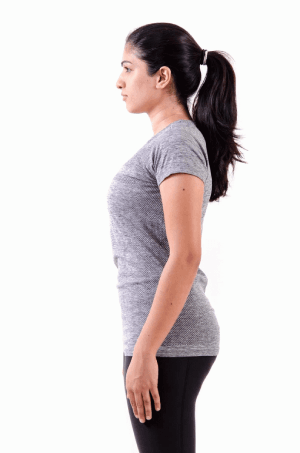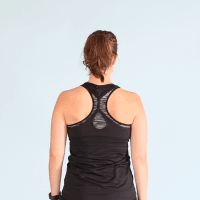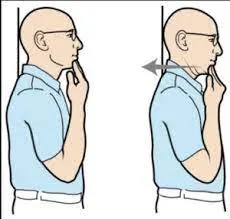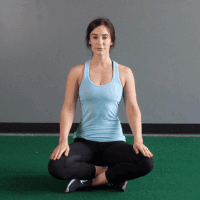Cervical spondylosis is a very common age-related condition, that can bring discomfort, pain, and reduced neck mobility into our lives. Fortunately, there’s hope for relief and improved quality of life through physiotherapy. In this blog, we’ll explore how physiotherapy plays a pivotal role in managing cervical spondylosis, helping individuals regain their neck strength, mobility, and overall well-being.
Contents
What Is Cervical Spondylosis?
Cervical spondylosis, also known as cervical osteoarthritis or neck arthritis, is a degenerative condition that affects the cervical spine. The cervical spine is the section of the spine located in the neck. It is a common age-related condition and is characterized by the deterioration of the vertebrae, discs, and joints in the neck over time.
Key features of cervical spondylosis include:
- Degeneration of Discs: The intervertebral discs in the cervical spine lose water content and become less flexible. This then leads to a reduction in disc height and increased friction between the vertebrae.
- Bone Spurs (Osteophytes): Over time, as the discs wear down, the body may respond by forming bony outgrowths called osteophytes or bone spurs. These can potentially press against spinal nerves or the spinal cord.
- Joint Changes: The facet joints in the neck may undergo degenerative changes, leading to pain and stiffness.
Cervical spondylosis often occurs as a result of the natural aging process. But it can also be accelerated by factors such as repetitive neck movements, poor posture, neck injuries (such as whiplash from car accidents), and genetics.
Common symptoms of cervical spondylosis may include neck pain, stiffness, headaches, and, in more severe cases, numbness or weakness in the arms or hands. Pain may radiate down the arms, and compression of nerve roots in the neck can lead to a condition called cervical radiculopathy.
Role Of Physiotherapy In Treatment Of Cervical Spondylosis
Physiotherapy offers a range of techniques and exercises aimed at reducing pain, improving mobility, and enhancing the overall quality of life for individuals with cervical spondylosis. Here’s a detailed look at the role of physiotherapy in cervical spondylosis treatment:
- Pain Management: Physiotherapists employ various pain relief techniques such as hot or cold therapy, ultrasound, and electrical stimulation to alleviate discomfort and muscle spasms associated with cervical spondylosis.
- Manual Therapy: Hands-on techniques like massage, joint mobilization, and manipulation are used to improve joint mobility. This can also help reduce muscle tension in the neck and upper back.
- Posture Correction: Physiotherapists assess posture and work with individuals in order to correct poor postural habits, which can contribute to the progression of cervical spondylosis.
- Neck Strengthening Exercises: Specific exercises target the muscles of the neck, shoulders, and upper back to improve strength and stability, reducing strain on the cervical spine.
- Range of Motion Exercises: Gentle exercises aim to improve the range of motion in the neck, making it easier for individuals to move their head and neck without pain or stiffness.
- Stretching Exercises: Stretching exercises help to lengthen tight muscles and increase flexibility, reducing tension in the neck and upper back.
- Ergonomic Advice: Physiotherapists provide guidance on ergonomics in the workplace and daily activities to reduce strain on the neck and spine.
- Modalities for Pain Relief: Modalities such as transcutaneous electrical nerve stimulation (TENS) or therapeutic ultrasound can be used to manage pain and reduce inflammation.
- 10. Lifestyle Modifications: – Physiotherapists work with individuals to make lifestyle changes, such as recommending ergonomic pillows or adjusting sleeping positions, to improve comfort during daily activities and sleep.
- Gradual Return to Activity: – If a physical activity or sports are limited due to cervical spondylosis, physiotherapists guide individuals through a gradual and safe return to these activities.
At-Home Exercises For Cervical Spondylosis
Exercise plays a crucial role in managing cervical spondylosis, but it’s essential to perform it correctly and without causing further strain. Always consult with a healthcare provider or physiotherapist before starting any exercise regimen for cervical spondylosis. Here are some at-home exercises that may be recommended, but remember to do them gently and stop if you experience pain or discomfort:
Neck Tilt Stretch
- Sit or stand up straight with your shoulders relaxed.
- Then, slowly tilt your head to the right, bringing your ear toward your shoulder.
- Hold for 15-30 seconds.
- Return your head to the neutral position.
- Repeat on the left side.
- Perform 2-3 times on each side.
Neck Flexion and Extension
- Sit or stand up straight.
- Slowly tilt your head forward, bringing your chin toward your chest.
- Hold for 15-30 seconds.
- After that slowly tilt your head backward, looking up toward the ceiling.
- Hold for 15-30 seconds.
- Return to the neutral position.
- Perform 2-3 times for each movement.
Shoulder Blade Squeeze
- Sit or stand with your arms at your sides.
- Squeeze your shoulder blades together as if you’re trying to hold a pencil between them.
- Hold for 5-10 seconds.
- Relax your shoulders.
- Repeat 10-15 times.
Chin Tucks
- Sit or stand with your shoulders relaxed.
- Gently tuck your chin toward your chest without moving your head forward.
- Hold for 5-10 seconds.
- Relax your neck.
- Repeat 10-15 times.
Neck Rotation
- Sit or stand up straight.
- Slowly turn your head to the right, trying to bring your chin toward your shoulder.
- Hold for 15-30 seconds.
- Return your head to the center.
- Repeat on the left side.
- Perform 2-3 times on each side.
Resistance Band Exercises
- You can use a resistance band to strengthen neck and upper back muscles. Attach the band to a sturdy anchor and perform exercises like neck extension, lateral flexion, and rotation, following your physiotherapist’s guidance.
Posture Correction
- Practice good posture by sitting or standing up straight, keeping your shoulders relaxed, and aligning your head with your spine.
Deep Breathing and Relaxation
- Stress can exacerbate cervical spondylosis symptoms. Practice deep breathing exercises and relaxation techniques to reduce stress and muscle tension.
Prevention Of Cervical Spondylosis
Preventing cervical spondylosis involves adopting healthy lifestyle habits and practices that reduce the risk of developing this condition or slowing down its progression. Here are some strategies for preventing cervical spondylosis:
- Maintain Good Posture: Practice proper posture when sitting, standing, and walking. Keep your head aligned with your spine and shoulders relaxed.
- Ergonomics: Use ergonomically designed furniture and equipment at work and home in order to minimize strain on your neck and back. Adjust your computer monitor, chair, and keyboard to maintain a neutral neck position.
- Stay Hydrated: Drink plenty of water to keep the intervertebral discs in your spine well-hydrated. Proper hydration helps maintain the flexibility and shock-absorbing properties of these discs.
- Manage Stress: Chronic stress can lead to muscle tension and poor posture. Practice stress-reduction techniques like yoga, meditation, or deep breathing exercises.
- Avoid Excessive Phone or Tablet Usage: Limit the time looking down at your smartphone, as this can strain the neck. Hold your devices at eye level whenever possible.
- Regular Breaks: If you have a desk job or spend long hours at a computer, take regular breaks to stretch and move around. This can help prevent neck strain.
- Use a Proper Pillow: Choose a comfortable and supportive pillow that maintains the natural curvature of your neck while you sleep. Your physiotherapist can recommend the best pillow for your needs.
- Avoid Smoking: Smoking reduces blood flow to the spine, which can impair the healing process and contribute to degeneration of the cervical discs. Quitting smoking can benefit overall spine health.
- Regular Check-ups: Visit your healthcare provider for regular check-ups and discuss any neck or back pain or discomfort promptly. Early detection and treatment of spinal issues can prevent further complications.
Conclusion
Cervical spondylosis can bring discomfort and limitations to our lives, but in the world of healthcare solutions, physiotherapy stands as a reliable source of relief and healing. Through this blog, we’ve explored how the power of physiotherapy can transform the experience of cervical spondylosis.
Physiotherapy isn’t just about exercises; it’s a journey toward better neck health and overall well-being. It’s about regaining control over your body, your comfort, and your life. With expert guidance, gentle exercises, and a holistic approach, physiotherapy equips you with the tools to overcome the challenges posed by cervical spondylosis.
Physical Therapy helps patients recover from pain. If you’re experiencing Back, Shoulder, Knee, Neck, Elbow, Hip, or Arthritis pain, a physical therapist at PhysioMantra can help: Book an online physical therapy session.












